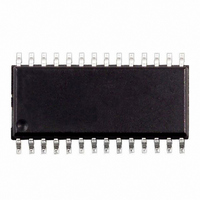ST62T65CM6 STMicroelectronics, ST62T65CM6 Datasheet - Page 18

ST62T65CM6
Manufacturer Part Number
ST62T65CM6
Description
IC MCU 8BIT OTP/EPROM 28 PSOIC
Manufacturer
STMicroelectronics
Series
ST6r
Datasheet
1.ST62T55CB6.pdf
(84 pages)
Specifications of ST62T65CM6
Core Processor
ST6
Core Size
8-Bit
Speed
8MHz
Connectivity
SPI
Peripherals
LED, LVD, POR, WDT
Number Of I /o
21
Program Memory Size
3.8KB (3.8K x 8)
Program Memory Type
OTP
Eeprom Size
128 x 8
Ram Size
128 x 8
Voltage - Supply (vcc/vdd)
3 V ~ 6 V
Data Converters
A/D 13x8b
Oscillator Type
Internal
Operating Temperature
-40°C ~ 85°C
Package / Case
28-SOIC (7.5mm Width)
Controller Family/series
ST6
No. Of I/o's
21
Eeprom Memory Size
128Byte
Ram Memory Size
128Byte
Cpu Speed
8MHz
No. Of Timers
2
Rohs Compliant
Yes
Processor Series
ST62T6x
Core
ST6
Data Bus Width
8 bit
Data Ram Size
128 B
Interface Type
SCI
Maximum Clock Frequency
8 MHz
Number Of Programmable I/os
21
Number Of Timers
1
Operating Supply Voltage
3 V to 6 V
Maximum Operating Temperature
+ 125 C
Mounting Style
SMD/SMT
Development Tools By Supplier
ST62GP-EMU2, ST62E2XC-EPB/110, ST62E6XC-EPB/US, STREALIZER-II
Minimum Operating Temperature
- 40 C
On-chip Adc
8 bit
Lead Free Status / RoHS Status
Lead free / RoHS Compliant
Other names
497-2103-5
Available stocks
Company
Part Number
Manufacturer
Quantity
Price
Company:
Part Number:
ST62T65CM6
Manufacturer:
ST
Quantity:
700
ST6255C ST6265C ST6265B
CLOCK SYSTEM (Cont’d)
Turning on the main oscillator is achieved by re-
setting the OSCOFF bit of the A/D Converter Con-
trol Register or by resetting the MCU. Restarting
the main oscillator implies a delay comprising the
oscillator start up delay period plus the duration of
the software instruction at f
3.1.2 Low Frequency Auxiliary Oscillator
(LFAO)
The Low Frequency Auxiliary Oscillator has three
main purposes. Firstly, it can be used to reduce
power consumption in non timing critical routines.
Secondly, it offers a fully integrated system clock,
without any external components. Lastly, it acts as
a safety oscillator in case of main oscillator failure.
This oscillator is available when the OSG ENA-
BLED option is selected. In this case, it automati-
cally starts one of its periods after the first missing
edge from the main oscillator, whatever the reason
(main oscillator defective, no clock circuitry provid-
ed, main oscillator switched off...).
User code, normal interrupts, WAIT and STOP in-
structions, are processed as normal, at the re-
duced f
cy is decreased, since the internal frequency is be-
low 1MHz.
At power on, the Low Frequency Auxiliary Oscilla-
tor starts faster than the Main Oscillator. It there-
fore feeds the on-chip counter generating the POR
delay until the Main Oscillator runs.
The Low Frequency Auxiliary Oscillator is auto-
matically switched off as soon as the main oscilla-
tor starts.
ADCR
Address: 0D1h — Read/Write
Bit 7-3, 1-0= ADCR7-ADCR3, ADCR1-ADCR0:
ADC Control Register. These bits are reserved for
ADC Control.
Bit 2 = OSCOFF. When low, this bit enables main
oscillator to run. The main oscillator is switched off
when OSCOFF is high.
3.1.3 Oscillator Safe Guard
The Oscillator Safe Guard (OSG) affords drastical-
ly increased operational integrity in ST62xx devic-
es. The OSG circuit provides three basic func-
18/84
ADCR
7
7
ADCR
LFAO
6
frequency. The A/D converter accura-
ADCR
5
ADCR
4
ADCR
LFAO
3
clock frequency.
OSC
OFF
ADCR
1
ADCR
0
0
tions: it filters spikes from the oscillator lines which
would result in over frequency to the ST62 CPU; it
gives access to the Low Frequency Auxiliary Os-
cillator (LFAO), used to ensure minimum process-
ing in case of main oscillator failure, to offer re-
duced power consumption or to provide a fixed fre-
quency low cost oscillator; finally, it automatically
limits the internal clock frequency as a function of
supply voltage, in order to ensure correct opera-
tion even if the power supply should drop.
The OSG is enabled or disabled by choosing the
relevant OSG option. It may be viewed as a filter
whose cross-over frequency is device dependent.
Spikes on the oscillator lines result in an effectively
increased internal clock frequency. In the absence
of an OSG circuit, this may lead to an over fre-
quency for a given power supply voltage. The
OSG filters out such spikes (as illustrated in
9). In all cases, when the OSG is active, the maxi-
mum internal clock frequency, f
f
lationship is illustrated in
When the OSG is enabled, the Low Frequency
Auxiliary Oscillator may be accessed. This oscilla-
tor starts operating after the first missing edge of
the main oscillator (see
Over-frequency, at a given power supply level, is
seen by the OSG as spikes; it therefore filters out
some cycles in order that the internal clock fre-
quency of the device is kept within the range the
particular device can stand (depending on V
and below f
cy with OSG enabled.
Note. The OSG should be used wherever possible
as it provides maximum safety. Care must be tak-
en, however, as it can increase power consump-
tion and reduce the maximum operating frequency
to f
Warning: Care has to be taken when using the
OSG, as the internal frequency is defined between
a minimum and a maximum value and is not accu-
rate.
For precise timing measurements, it is not recom-
mended to use the OSG and it should not be ena-
bled in applications that use the SPI or the UART.
It should also be noted that power consumption in
Stop mode is higher when the OSG is enabled
(around 50µA at nominal conditions and room
temperature).
OSG
OSG
, which is supply voltage dependent. This re-
.
OSG
: the maximum authorised frequen-
Figure
Figure
10).
12.
INT
, is limited to
Figure
DD
),













